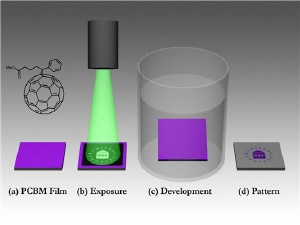Mar 25 2009
Flexible display screens and cheap solar cells can become a reality through research and development in organic electronics. Physicists at Umeå University in Sweden have now developed a new and simple method for producing cheap electronic components.

"The method is simple and can therefore be of interest for future mass production of cheap electronics," says physicist Ludvig Edman.
Organic chemistry is a rapidly expanding research field that promises exciting and important applications such as flexible display screens and cheap solar cells. One attractive feature is that organic electronic materials can be processed from a solution.
"This makes it possible to paint thin films of electronic materials on flexible surfaces like paper or plastic," explains Ludvig Edman.
Electronic components with various functions can then be created by patterning the film with a specific structure. Until now it has proven to be problematic to carry out this patterning in a simple way without destroying the electronic properties of the organic material.
"We have now developed a method that enables us to create patterns in an efficient and gentle way. With the patterned organic material as a base, we have managed to produce well-functioning transistors," says Ludvig Edman.
A thin film of an organic electronic material, a so-called fullerene, is first painted on a selected surface. The parts of the film that are to remain in place are directly exposed to laser light. Then the whole film can be developed by rinsing it with a solution. A well-defined pattern then emerges where the laser light hit the surface.
A key advantage with this method of patterning is that it is both simple and scalable, which means that it can be useful in future production of cheap and flexible electronics in an assembly line process.
Other researchers involved in developing the method are Andrzej Dzwilewski and Thomas Wågberg.
The findings are presented in the industry publication Journal of the American Chemical Society (2009, 131, 4006-4011)